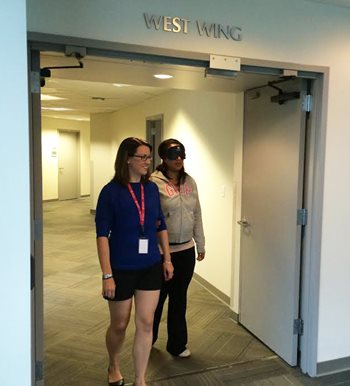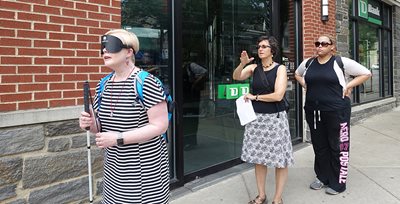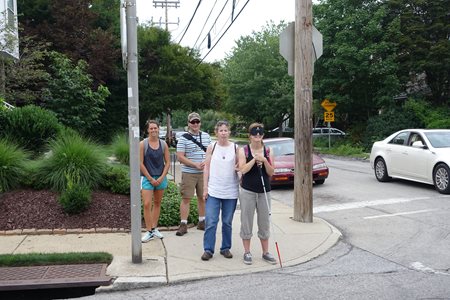 Students from the University’s Master of Science degree program in Orientation and Mobility (O&M) take their classes in a variety of formats. These formats include online, classroom lectures, a combination of both, and hands-on experience each summer in Elkins Park on the University’s campus.
Students from the University’s Master of Science degree program in Orientation and Mobility (O&M) take their classes in a variety of formats. These formats include online, classroom lectures, a combination of both, and hands-on experience each summer in Elkins Park on the University’s campus.
It’s a common sight in June, when other programs have a break and there are fewer students on campus, to see groups of blindfolded students from the College of Education and Rehabilitation being led and then directed along the hallways of Salus. Some of the students may have visual impairments or blindness and their guide dogs are a welcome addition to campus life.
A week or two later the O&M students have progressed to using white canes and the tap, tap – and occasional clunk – sounds they generate while trying to get their bearings are normal summer sounds to the University community.
Once they master interior mobility, the students graduate to campus parking lots and sidewalks. When their instructors are confident in their ability to navigate, the students’ real-life training begins at train stations and bus stops and on neighborhood streets.
On a warm day in July, Dr. Fabiana Perla, director of the O&M program and chair of the Department of Blindness and Low Vision Studies worked with students Gloria Hiten and Amber Clark on Germantown Avenue, the busiest street in the Chestnut Hill section of Philadelphia.
 With Gloria blindfolded and using a white cane while Amber observed, Dr. Perla reviewed steps that Gloria needed to concentrate on in order to navigate the sidewalks and street safely and confidently. After a few block-long forays from the train station down “the Avenue,” to orient herself and practice listening to the traffic, Gloria began her assignment: to navigate from the station to the Chestnut Hill Welcome Center, located across Germantown Avenue, down two blocks and up a side street. The rule was that Gloria could stop and ask for help once during her walk but needed to self-navigate the rest of the time.
With Gloria blindfolded and using a white cane while Amber observed, Dr. Perla reviewed steps that Gloria needed to concentrate on in order to navigate the sidewalks and street safely and confidently. After a few block-long forays from the train station down “the Avenue,” to orient herself and practice listening to the traffic, Gloria began her assignment: to navigate from the station to the Chestnut Hill Welcome Center, located across Germantown Avenue, down two blocks and up a side street. The rule was that Gloria could stop and ask for help once during her walk but needed to self-navigate the rest of the time.
With Dr. Perla and Amber ready to ward off unforeseen danger and trailing at a safe distance, Gloria set off. Several people along her path kindly offered Gloria unsolicited help that she didn’t need as she took her time over the (sometimes) uneven and cracked sidewalks. Following a path that might take a sighted person six minutes to walk (allowing for red lights), Gloria reached the Welcome Center in about 18 minutes, after several stops and starts to orient herself and listen closely to the traffic sounds – some of them over the noise of a large armored truck idling at a corner – no easy feat.
 Meanwhile, a few streets away from the busy Germantown Avenue, adjunct faculty member Betsy O’Donnell and students Kristin Dibler, Chris Siller and Samantha McGovern navigate neighborhoods. These streets are quieter but just as dangerous as curbs are not well-defined in some intersections and, in addition to cars and trucks, the students must contend with pedestrian traffic, virtually soundless electric cars and kids on bicycles.
Meanwhile, a few streets away from the busy Germantown Avenue, adjunct faculty member Betsy O’Donnell and students Kristin Dibler, Chris Siller and Samantha McGovern navigate neighborhoods. These streets are quieter but just as dangerous as curbs are not well-defined in some intersections and, in addition to cars and trucks, the students must contend with pedestrian traffic, virtually soundless electric cars and kids on bicycles.
The goal of real-life training is to have students gain critical information, skills and experience that they can transfer to their clients when they begin working. For the instructors, it is a time of ensuring that the theory and process learned in class becomes a strong reality for their students. For the students, it is invaluable, hands-on practicum learned in a supportive atmosphere that encourages questions and supplies answers. For the campus community it is the realization that they have the rare opportunity to see firsthand the teaching and the actual learning that occurs in a Salus University program. To watch the progression of skill levels and self-confidence as O&M students navigate from protected hallways to big city intersections is a testament to the quality of our faculty, our students and our programs.